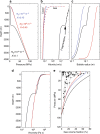Controls on explosive-effusive volcanic eruption styles
- PMID: 30026543
- PMCID: PMC6053376
- DOI: 10.1038/s41467-018-05293-3
Controls on explosive-effusive volcanic eruption styles
Abstract
One of the biggest challenges in volcanic hazard assessment is to understand how and why eruptive style changes within the same eruptive period or even from one eruption to the next at a given volcano. This review evaluates the competing processes that lead to explosive and effusive eruptions of silicic magmas. Eruptive style depends on a set of feedback involving interrelated magmatic properties and processes. Foremost of these are magma viscosity, gas loss and external properties such as conduit geometry. Ultimately, these parameters control the speed at which magmas ascend, decompress and outgas en route to the surface, and thus determine eruptive style and evolution.
Figures







References
-
- Brown, S. K., Jenkins, S. F., Sparks, R. S. J., Odbert, H. & Auker, M. R. Volcanic fatalities database: analysis of volcanic threat with distance and victim classification. J. Appl. Volcanol. 6, 15 (2017).
-
- Cionia R, Bertagnini A, Santacroce R, Andronico D. Explosive activity and eruption scenarios at Somma-Vesuvius (Italy): towards a new classification scheme. J. Volcanol. Geotherm. Res. 2008;178:331–346. doi: 10.1016/j.jvolgeores.2008.04.024. - DOI
-
- Venzke, E. (Ed). Global Volcanism Program | Volcanoes of the World (VOTW) Database Information v. 4.6.6 (Smithsonian Institution, Washington, DC, 2013). Available at: http://volcano.si.edu/gvp_votw.cfm.
-
- National Academies of Sciences, E. and M. Volcanic Eruptions and Their Repose, Unrest, Precursors, and Timing (National Academies Press, Washington, DC, 2017). 10.17226/24650.
-
- Cashman KV, Stephen R, Sparks J. How volcanoes work: a 25 year perspective. Bull. Geol. Soc. Am. 2013;125:664–690. doi: 10.1130/B30720.1. - DOI
Publication types
Grants and funding
- NE/N014286/1/Natural Environment Research Council (NERC)/International
- NSF-1521855 Hazard SEES/National Science Foundation (NSF)/International
- Royal Society Wolfson Merit Award/Royal Society/International
- 200021_178928/Schweizerischer Nationalfonds zur Förderung der Wissenschaftlichen Forschung (Swiss National Science Foundation)/International
LinkOut - more resources
Full Text Sources
Other Literature Sources
Research Materials

